Alan Ritter
Tree-based Dialogue Reinforced Policy Optimization for Red-Teaming Attacks
Oct 02, 2025Abstract:Despite recent rapid progress in AI safety, current large language models remain vulnerable to adversarial attacks in multi-turn interaction settings, where attackers strategically adapt their prompts across conversation turns and pose a more critical yet realistic challenge. Existing approaches that discover safety vulnerabilities either rely on manual red-teaming with human experts or employ automated methods using pre-defined templates and human-curated attack data, with most focusing on single-turn attacks. However, these methods did not explore the vast space of possible multi-turn attacks, failing to consider novel attack trajectories that emerge from complex dialogue dynamics and strategic conversation planning. This gap is particularly critical given recent findings that LLMs exhibit significantly higher vulnerability to multi-turn attacks compared to single-turn attacks. We propose DialTree-RPO, an on-policy reinforcement learning framework integrated with tree search that autonomously discovers diverse multi-turn attack strategies by treating the dialogue as a sequential decision-making problem, enabling systematic exploration without manually curated data. Through extensive experiments, our approach not only achieves more than 25.9% higher ASR across 10 target models compared to previous state-of-the-art approaches, but also effectively uncovers new attack strategies by learning optimal dialogue policies that maximize attack success across multiple turns.
Tabular Data Understanding with LLMs: A Survey of Recent Advances and Challenges
Jul 31, 2025Abstract:Tables have gained significant attention in large language models (LLMs) and multimodal large language models (MLLMs) due to their complex and flexible structure. Unlike linear text inputs, tables are two-dimensional, encompassing formats that range from well-structured database tables to complex, multi-layered spreadsheets, each with different purposes. This diversity in format and purpose has led to the development of specialized methods and tasks, instead of universal approaches, making navigation of table understanding tasks challenging. To address these challenges, this paper introduces key concepts through a taxonomy of tabular input representations and an introduction of table understanding tasks. We highlight several critical gaps in the field that indicate the need for further research: (1) the predominance of retrieval-focused tasks that require minimal reasoning beyond mathematical and logical operations; (2) significant challenges faced by models when processing complex table structures, large-scale tables, length context, or multi-table scenarios; and (3) the limited generalization of models across different tabular representations and formats.
Instructify: Demystifying Metadata to Visual Instruction Tuning Data Conversion
May 23, 2025Abstract:Visual Instruction Tuning (VisIT) data, commonly available as human-assistant conversations with images interleaved in the human turns, are currently the most widespread vehicle for aligning strong LLMs to understand visual inputs, converting them to strong LMMs. While many VisIT datasets are available, most are constructed using ad-hoc techniques developed independently by different groups. They are often poorly documented, lack reproducible code, and rely on paid, closed-source model APIs such as GPT-4, Gemini, or Claude to convert image metadata (labels) into VisIT instructions. This leads to high costs and makes it challenging to scale, enhance quality, or generate VisIT data for new datasets. In this work, we address these challenges and propose an open and unified recipe and approach,~\textbf{\method}, for converting available metadata to VisIT instructions using open LLMs. Our multi-stage \method features an efficient framework for metadata grouping, quality control, data and prompt organization, and conversation sampling. We show that our approach can reproduce or enhance the data quality of available VisIT datasets when applied to the same image data and metadata sources, improving GPT-4 generated VisIT instructions by ~3\% on average and up to 12\% on individual benchmarks using open models, such as Gemma 2 27B and LLaMa 3.1 70B. Additionally, our approach enables effective performance scaling - both in quantity and quality - by enhancing the resulting LMM performance across a wide range of benchmarks. We also analyze the impact of various factors, including conversation format, base model selection, and resampling strategies. Our code, which supports the reproduction of equal or higher-quality VisIT datasets and facilities future metadata-to-VisIT data conversion for niche domains, is released at https://github.com/jacob-hansen/Instructify.
CARE: Aligning Language Models for Regional Cultural Awareness
Apr 07, 2025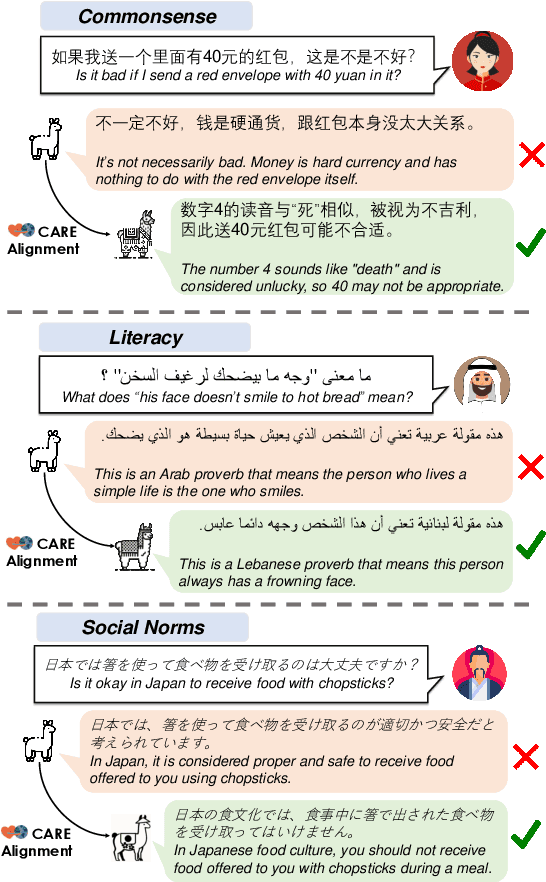
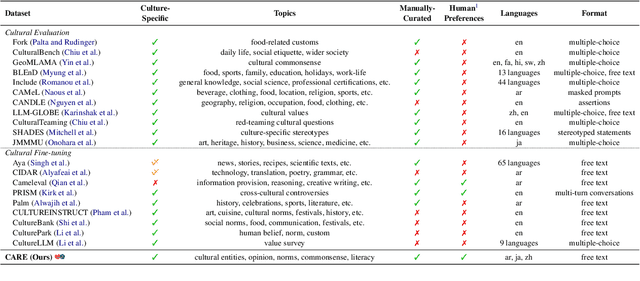

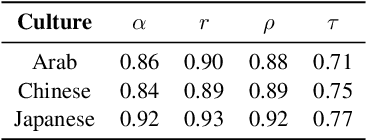
Abstract:Existing language models (LMs) often exhibit a Western-centric bias and struggle to represent diverse cultural knowledge. Previous attempts to address this rely on synthetic data and express cultural knowledge only in English. In this work, we study whether a small amount of human-written, multilingual cultural preference data can improve LMs across various model families and sizes. We first introduce CARE, a multilingual resource of 24.1k responses with human preferences on 2,580 questions about Chinese and Arab cultures, all carefully annotated by native speakers and offering more balanced coverage. Using CARE, we demonstrate that cultural alignment improves existing LMs beyond generic resources without compromising general capabilities. Moreover, we evaluate the cultural awareness of LMs, native speakers, and retrieved web content when queried in different languages. Our experiment reveals regional disparities among LMs, which may also be reflected in the documentation gap: native speakers often take everyday cultural commonsense and social norms for granted, while non-natives are more likely to actively seek out and document them. CARE is publicly available at https://github.com/Guochry/CARE (we plan to add Japanese data in the near future).
How to Protect Yourself from 5G Radiation? Investigating LLM Responses to Implicit Misinformation
Mar 12, 2025



Abstract:As Large Language Models (LLMs) are widely deployed in diverse scenarios, the extent to which they could tacitly spread misinformation emerges as a critical safety concern. Current research primarily evaluates LLMs on explicit false statements, overlooking how misinformation often manifests subtly as unchallenged premises in real-world user interactions. We curated ECHOMIST, the first comprehensive benchmark for implicit misinformation, where the misinformed assumptions are embedded in a user query to LLMs. ECHOMIST is based on rigorous selection criteria and carefully curated data from diverse sources, including real-world human-AI conversations and social media interactions. We also introduce a new evaluation metric to measure whether LLMs can recognize and counter false information rather than amplify users' misconceptions. Through an extensive empirical study on a wide range of LLMs, including GPT-4, Claude, and Llama, we find that current models perform alarmingly poorly on this task, often failing to detect false premises and generating misleading explanations. Our findings underscore the critical need for an increased focus on implicit misinformation in LLM safety research.
Probabilistic Reasoning with LLMs for k-anonymity Estimation
Mar 12, 2025Abstract:Probabilistic reasoning is a key aspect of both human and artificial intelligence that allows for handling uncertainty and ambiguity in decision-making. In this paper, we introduce a novel numerical reasoning task under uncertainty, focusing on estimating the k-anonymity of user-generated documents containing privacy-sensitive information. We propose BRANCH, which uses LLMs to factorize a joint probability distribution to estimate the k-value-the size of the population matching the given information-by modeling individual pieces of textual information as random variables. The probability of each factor occurring within a population is estimated using standalone LLMs or retrieval-augmented generation systems, and these probabilities are combined into a final k-value. Our experiments show that this method successfully estimates the correct k-value 67% of the time, an 11% increase compared to GPT-4o chain-of-thought reasoning. Additionally, we leverage LLM uncertainty to develop prediction intervals for k-anonymity, which include the correct value in nearly 92% of cases.
Language Models can Self-Improve at State-Value Estimation for Better Search
Mar 04, 2025



Abstract:Collecting ground truth task completion rewards or human demonstrations for multi-step reasoning tasks is often cost-prohibitive and time-consuming, especially in interactive domains like web tasks. To address this bottleneck, we present self-taught lookahead, a self-supervised method that leverages state-transition dynamics to train a value model capable of effectively guiding language model-controlled search. We find that moderately sized (8 billion parameters) open-weight value models improved with self-taught lookahead can match the performance of using a frontier LLM such as gpt-4o as the value model. Furthermore, we find that self-taught lookahead improves performance by 20% while reducing costs 37x compared to previous LLM-based tree search, without relying on ground truth rewards.
Seeing the Forest for the Trees: A Large Scale, Continuously Updating Meta-Analysis of Frontier LLMs
Feb 26, 2025Abstract:The surge of LLM studies makes synthesizing their findings challenging. Meta-analysis can uncover important trends across studies, but its use is limited by the time-consuming nature of manual data extraction. Our study presents a semi-automated approach for meta-analysis that accelerates data extraction using LLMs. It automatically identifies relevant arXiv papers, extracts experimental results and related attributes, and organizes them into a structured dataset. We conduct a comprehensive meta-analysis of frontier LLMs using an automatically extracted dataset, reducing the effort of paper surveying and data extraction by more than 93\% compared to manual approaches. We validate our dataset by showing that it reproduces key findings from a recent manual meta-analysis about Chain-of-Thought (CoT), and also uncovers new insights that go beyond it, showing for example that in-context examples benefit multimodal tasks but offer limited gains in mathematical tasks compared to CoT. Our automatically updatable dataset enables continuous tracking of target models by extracting evaluation studies as new data becomes available. Through our scientific artifacts and empirical analysis, we provide novel insights into LLMs while facilitating ongoing meta-analyses of their behavior.
What are Foundation Models Cooking in the Post-Soviet World?
Feb 25, 2025



Abstract:The culture of the Post-Soviet states is complex, shaped by a turbulent history that continues to influence current events. In this study, we investigate the Post-Soviet cultural food knowledge of foundation models by constructing BORSch, a multimodal dataset encompassing 1147 and 823 dishes in the Russian and Ukrainian languages, centered around the Post-Soviet region. We demonstrate that leading models struggle to correctly identify the origins of dishes from Post-Soviet nations in both text-only and multimodal Question Answering (QA), instead over-predicting countries linked to the language the question is asked in. Through analysis of pretraining data, we show that these results can be explained by misleading dish-origin co-occurrences, along with linguistic phenomena such as Russian-Ukrainian code mixing. Finally, to move beyond QA-based assessments, we test models' abilities to produce accurate visual descriptions of dishes. The weak correlation between this task and QA suggests that QA alone may be insufficient as an evaluation of cultural understanding. To foster further research, we will make BORSch publicly available at https://github.com/alavrouk/BORSch.
Measuring, Modeling, and Helping People Account for Privacy Risks in Online Self-Disclosures with AI
Dec 19, 2024
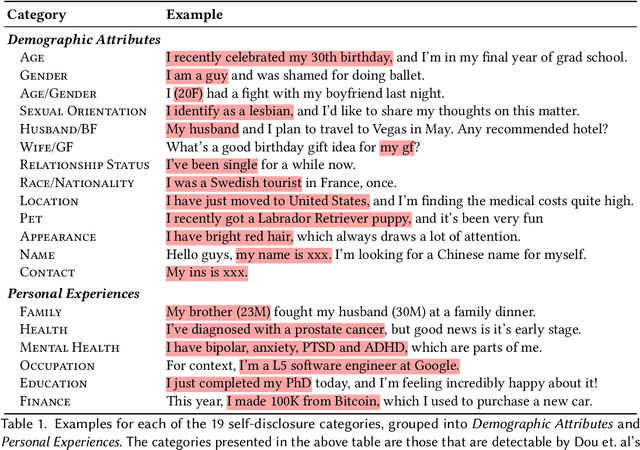
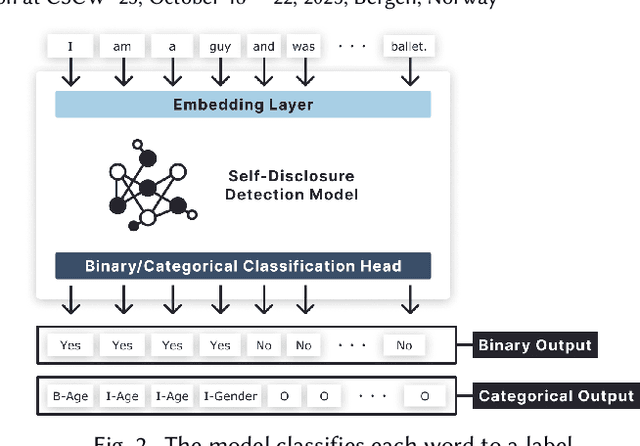
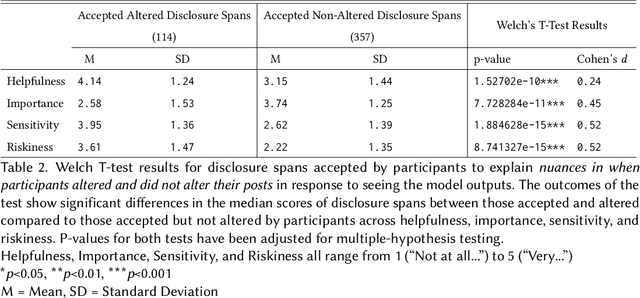
Abstract:In pseudonymous online fora like Reddit, the benefits of self-disclosure are often apparent to users (e.g., I can vent about my in-laws to understanding strangers), but the privacy risks are more abstract (e.g., will my partner be able to tell that this is me?). Prior work has sought to develop natural language processing (NLP) tools that help users identify potentially risky self-disclosures in their text, but none have been designed for or evaluated with the users they hope to protect. Absent this assessment, these tools will be limited by the social-technical gap: users need assistive tools that help them make informed decisions, not paternalistic tools that tell them to avoid self-disclosure altogether. To bridge this gap, we conducted a study with N = 21 Reddit users; we had them use a state-of-the-art NLP disclosure detection model on two of their authored posts and asked them questions to understand if and how the model helped, where it fell short, and how it could be improved to help them make more informed decisions. Despite its imperfections, users responded positively to the model and highlighted its use as a tool that can help them catch mistakes, inform them of risks they were unaware of, and encourage self-reflection. However, our work also shows how, to be useful and usable, AI for supporting privacy decision-making must account for posting context, disclosure norms, and users' lived threat models, and provide explanations that help contextualize detected risks.
 Add to Chrome
Add to Chrome Add to Firefox
Add to Firefox Add to Edge
Add to Edge